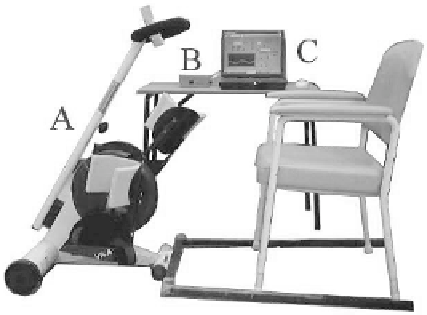Biomedical Engineering Reference
In-Depth Information
min
−
1
and the resistive
difficult when the desired target cadence is below 35 rev
·
load is high.
7.5.2 Motorized FES Cycle Ergometers
An alternative to flywheel-braked cycling is to employ a motor to assist cycling
(Eichhorn, 1984). For subjects with sufficient muscle power, the motor can be used
to provide a pedalling resistance. The motor can also be used to calculate and
correct for the energy required to passively move the legs and flywheel (Davis,
2001; Hunt, 2003). The motor has the advantage of enabling very weak subjects to
perform FES cycling exercise, but a motorised system may pose an injury risk to
the SCI subject's lower limbs. Safety precautions must be taken to limit the torque
that the motor applies to the limbs of paralysed individuals. Recent technological
advances have lead to the development of specialized low-power motorized cycle
ergometers with safety features that prevent muscle injury (e.g. Motomed VIVA,
Reck Medizentechnik Gm
β
H, Germany) and can be integrated with FES.
7.5.3 Isokinetic FES Cycling Exercise
Recently, an isokinetic functional electrical stimulation leg cycle ergometer (iFES-
The iFES-LCE system was created from a motorized cycle ergometer, a computer,
custom-designed software, and a laboratory-constructed six-channel transcuta-
neous neuromuscular stimulator.
It was designed to allow cycle training over a broad range of pedalling
cadences (5-60 rev
min
−
1
, while providing accurate real-time feedback of muscle
performance, to promote the development of both muscular strength and car-
diorespiratory fitness. The inherent flexibility of the new system has made it very
·
)
Figure 7.3
The iFES-LCE exercise system. Shown are a Motomed Viva
R
(A), the DS2000
neuromuscular stimulator (B), the control computer (C), and a chair for the subject. For
color reference, see page 217.

















